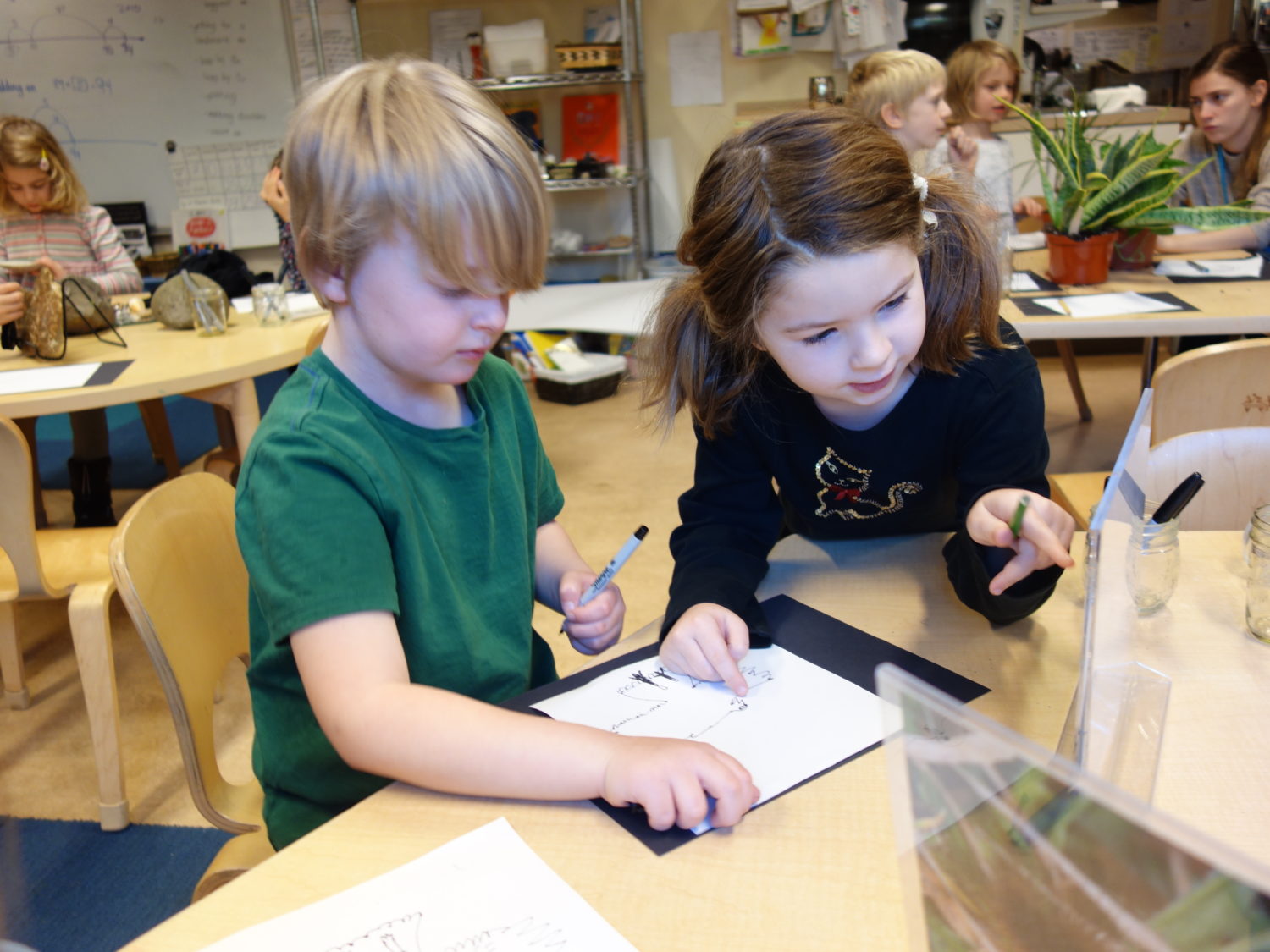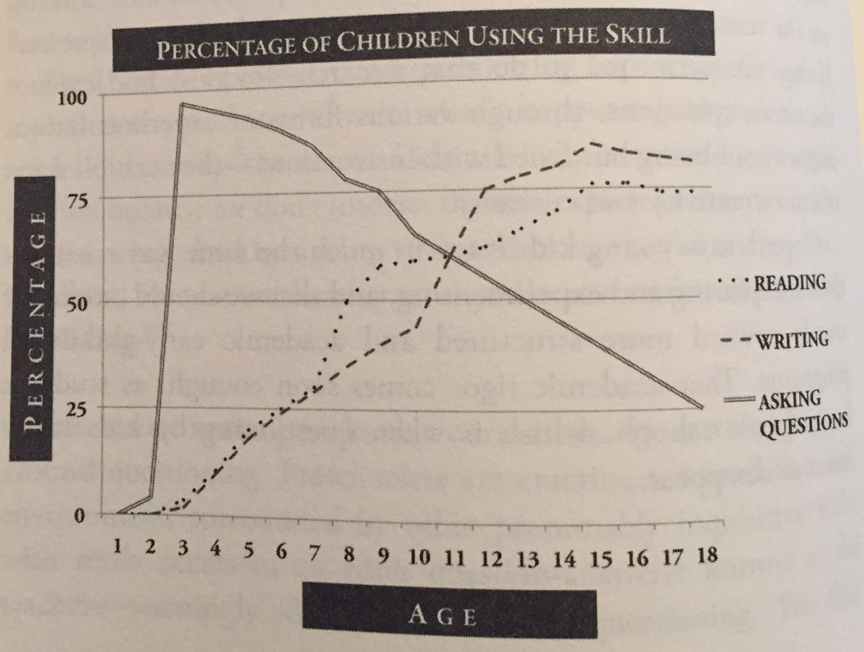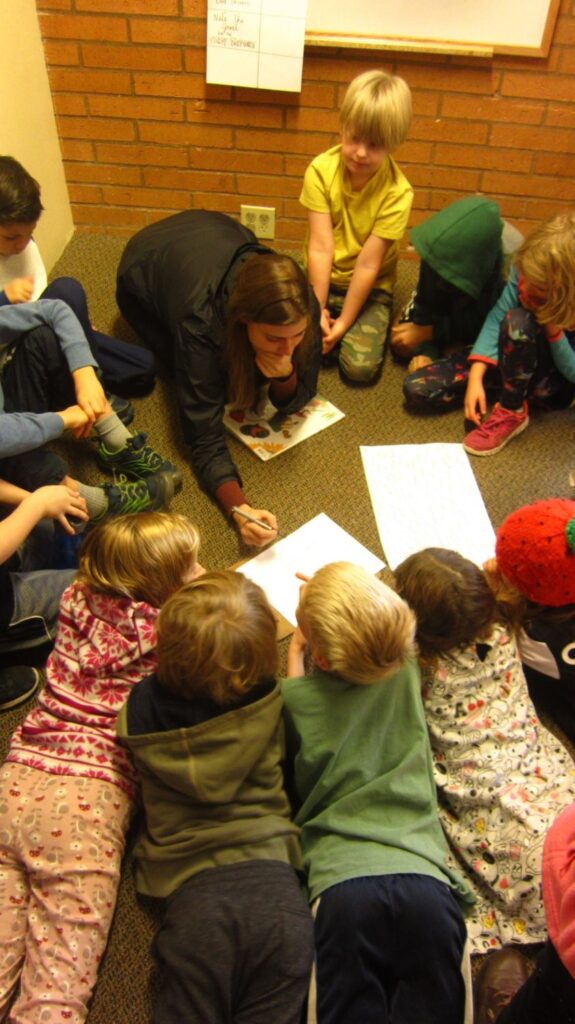Curiosity

Last night I was reading a story to my two-year-old son. On each page he stopped to ask me a question. Sometimes I tried to answer with what I thought, sometimes I asked him what he thought, and sometimes I told him I didn’t know. No matter what I said to him, he followed up with, “but why?” And again I would respond, and again he would respond with, “but why?” This interaction with his persistent “but whys” reminded me of the innate sense of curiosity that children are born with. Human beings are wired with a strong desire to figure out how the world works. His questions also made me pause to consider my own responses to him. How were my responses supporting this innate sense of curiosity or shutting it down?
I know that hearing a two-year-old ask “why” is not an uncommon experience. But I also know that that willingness to ask “why” tends to decrease over time. This image from A More Beautiful Question by Warren Berger comes to mind.

Research has shown that the frequency children ask questions decreases over time. But curiosity is one of the most powerful ingredients in learning. In the same way I wondered about my role in supporting or shutting down my son’s curiosity, I also wonder about my role as a teacher. Where are those “but why” moments showing up in the Dogwood community of first and second-graders that I work with this year? What am I doing to invite, sustain, and extend those natural curiosities?
I want to share a recent dialogue that we had in the Dogwood community and some of my own observations and questions about the role of curiosity within it. I had asked the children to share their observations about what they’ve been noticing in the new exhibit they’d designed at the Portland Children’s Museum (read more about that here). Many shared observations about children visiting the exhibit using the markers to draw on the shelf that the children in Dogwood had designed.
Nathan: I noticed a lot of people drawing on the shelf and it feels really disrespectful.
Kerry: Did anyone notice that and have a different feeling?
Frank: My feeling is different. It was that I understand that they drew on it because they’re a lot littler.
Samantha: At first yes, I was thinking what Nathan was thinking, but now I think it’s kind of nice. They’re basically trying to show their color just like we did, if you think of it another way.
Albert: People have taken the caps off pens, and are drawing all around. They were taking the pens and scribbling and I felt really disappointed.
Walter: I saw that other kids were using materials for making some other things. I really feel happy about it.
Evelyn: That was the intention for it.
Anaise: I liked that they drew on our shelf because at first I thought, seriously, then I thought about it a new way.
Louis: Me too. I was disappointed at first, but then when I thought about it for a minute, I was like, it’s just a plain old shelf, maybe they’re trying to make it better.
The first thing I noticed was how these children shared their emotions as they shared their observations. It feels important to me that they can communicate different ideas with one another about how they are feeling, and that there is space for all of these different emotions to be felt. I didn’t hear any messages that communicated any of those feelings didn’t belong.
The next thing I noticed was how multiple children described how they moved beyond their first reaction. Samantha said, “…if you kind of think of it another way.” And Louis said, “…I thought about it for a minute…” These moments made me wonder about the connection between assumptions and curiosity. We all make assumptions, but what are the conditions that support us to either stay in those assumptions, or get curious? What was it that allowed Louis and others to “think about it for a minute” and move past that feeling of disappointment? How does having a model of what it might look like or sound like to look at something from another perspective in moments of uncertainty or disappointment support a culture of curiosity? What is the role of curiosity in having a sense of agency and taking action?

I was wondering about what questions the children had related to their observations, so I asked them, “Based on your observations of the exhibit, what do you want to know more about? What are you wondering?”
Max: If, well I know that people are enjoying it, but I wonder if their plans that they had in their minds were working.
Louis: I really want to know if they’re having fun or not.
Frank: I’m wondering if they have any ideas for us. If they have any ideas they can add to the exhibit.
Avery: I’m wondering what they would add.
Nathan: I’m curious about how are they using the materials.
Anna: Are we going to change our part or flex it? Or if they (the visitors) did do that, how would they change it?
We paused the conversation here, with the intention to go out into the exhibit to do some more research around these questions. The children shared that they would need time and notebooks to continue this research. This week we’ll meet with staff from both the Exhibits and Museum Experience departments of the Portland Children’s Museum to share our observations as well as hear from other perspectives. My hope is that in Dogwood, we can let curiosity guide the way we receive feedback and make revisions for this exhibit. I look forward to sharing more with you soon.
As I reflect on this small moment, I wonder about my role and about the conditions I’m working to create that may have invited, sustained, or extended curiosity that can be applied beyond this one experience. Here are some of the things that are standing out to me:
- An invitation to share observations and questions was offered. Asking “What do you notice? What do you wonder?” sets the expectation that there is always something to pay attention to and always something to get curious about.
- Thinking about what else it could be (are there other reasons people might be drawing on the shelf?) supports a habit of seeking different perspectives and being curious about what else might be going on.
- Asking questions that I don’t already have a preconceived answer to and that I am genuinely curious about and inviting children to do the same builds a culture that isn’t about one answer or a “right” answer, but about all of us (adults and children) thinking and wondering together.
- Making sure all emotions are valued and seeking ways to move forward. I want to support children to feel a sense of agency and to have strategies for taking action. I want there to be space for all emotions but also to not let feelings of disappointment or frustration keep us from continuing to ask questions or plan next steps to take.
Reader, I’m wondering:
Where are you noticing curiosity show up in your day?
What are you curious about? What are the children you work with curious about?
What are you doing to support and nurture a sense of curiosity?
What connections are you noticing between assumptions and curiosity? Between taking action and curiosity?
